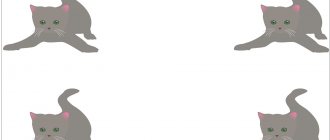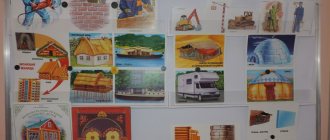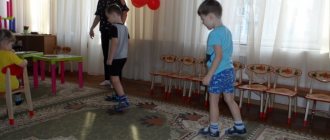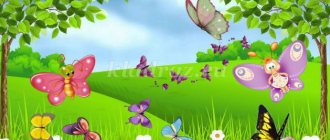GCD in mathematics (Middle group)
Math lesson.
Topic: Kaleidoscope of mathematical games.
Target :
Strengthen a certain stock of mathematical knowledge and skills. Contribute to consolidation of knowledge of numbers, development of observation, memory, imagination. Consolidate knowledge about geometric figures, quantitative relationships between numbers. Develop logical thinking and perseverance.
Area:
cognitive development.
Material:
a set of digital cards, counting sticks, a set of toys, a set of circles and squares, cards with 2 stripes, chips, a ball.
Progress of the lesson:
Guys, today we will go by bus. I suggest buying tickets at the box office and taking seats according to the ticket. We will now go to the toy store. You've taken your seats, now tell me your seat number, it matches your ticket number, then you're great, let's go. Stop. A toy shop
.
In the store next to the toys there are cards with numbers indicating the price of the toy. Children, with your ticket cards you can “buy” a toy. But, you can only buy a toy about which you correctly tell: where it costs and how much it costs ( name the number).
Children sit on the bus in their seats with toys. Wow, the bus broke down. We need to find the breakdown. Children leave their toys on the bus and go to the tables where there are strips with a row of geometric shapes, where the pattern is broken
. Children explain where the pattern is broken and correct it.
The bus breakdown has been fixed, we can move on. We've arrived. Children place toys on tables and chairs. I suggest playing the game “Count - don’t be mistaken!” with the ball .
Children pass the ball around and count to 5 at a fast pace and several times. Guys, Bunny came to visit us, he also wants to play with us. He loves to catch up with the ball. Pass the ball in a circle, and then Bunny.
Children, sit down, we will play the game “What has changed.”
Consider how the toys stand. At my signal “night”, you close your eyes, “day” - open your eyes and say which toy is gone, put it in its place and say between which toys this toy was standing.
The next game is “Confusion”.
I lay out the numbers on the board. At the moment when the children close their eyes, I change the numbers. Children find these changes and return the numbers to their places.
Guys, please take five sticks out of the box. Build a square of four sticks, and place the fifth stick so that you get two triangles. Now take another stick and build a house. What shapes made the house (square and triangle). Well done. Now make a square and two triangles from five sticks. Well done.
of geometric figures came to visit us
, they ask you to help them solve the riddle, but you must name these shapes (circle, oval, rectangle, square, triangle). Listen carefully to the riddle: “Tili bom, tili bom, The cat’s house caught fire. A chicken runs with a bucket, a cockerel with a jug, a horse with a lantern, a gray bunny with a leaf, a squirrel with a mushroom, once, once, and the fire goes out.” Guys, how many birds and animals put out the fire? (5) How many birds? How many animals?
Another mystery
: “A puppy is sitting on the porch, warming his fluffy side, another one came running and sat down next to him. How many puppies are there? (2).
Game "How much?"
guys, you need to guess one more riddle: A girl is sitting in a dungeon, and her scythe is on the street. Yes, it's a carrot. We count how many carrots are drawn in the pictures and show the corresponding number. Whoever picks up the card with the number faster gets a chip.
Now we will bring the numbers to life, the game “ Live Numbers”
I choose children, attach numbers to them, the children run to the beat of a tambourine, then stop and stand in a row in order. The rest of the children check whether the “numbers” are correct or not and correct the mistake. The game is repeated several times.
Our journey has come to an end. Well done. Tell me what math games
you liked it and we will play with you again later. For the fact that you were active and played together, helping each other, you all get stars.
Summary of the lesson on FEMP “Mathematical journey into the winter forest” in the middle group
Summary of the lesson on FEMP “Mathematical journey into the winter forest” in the middle group
Author: Kuchukova Lyubov Anisimovna, teacher of MBDOU No. 44, Miass, Chelyabinsk region. Description of the material: the summary is aimed at strengthening the ability to count within five, designate the number of objects with a number, compare and equalize sets, etc. In addition, the lesson material will help consolidate children’s knowledge about the life of animals in the winter forest.
The goal is for children to be able to count within five and denote the number with a number. Objectives: 1. consolidate children’s ability to count to 5, indicate the number of objects with the corresponding number; 2. consolidate the ability to compare sets based on counting; 3. consolidate knowledge about geometric shapes; 4. practice determining the spatial position of objects. Materials and equipment: basket, silhouettes of carrots (4 pcs.), nuts, barrel of honey; silhouettes of hares (4 pcs.), Hare toy, tree silhouette, squirrel silhouette, number cards (1 pc. for each child); numbers 1-5, pasted on the lockers in the group; a screen house with number cards with five objects attached to it, envelopes with the game “Geometric Constructor” and a sample image (1 piece for each child). Progress of the lesson: Teacher. - Guys, number 5 found out that you learned to count to five, and invited you to visit. But they don’t go on a visit without gifts! We have a long way ahead, through the forest. What if we meet someone in the forest?! A discussion is held about who might meet in the forest. Children choose gifts - silhouettes of carrots, mushrooms, nuts, a barrel of honey. An audio recording with the sounds of a blizzard is turned on. Children follow the teacher, performing the following movements: - we walk through the snowdrifts, raise our legs high; - We crawl under the spruce branches. Educator. - Here we are in a forest clearing! Look, here is a bunny under a bush (the teacher draws the children’s attention to the toy – a hare). He's just kind of sad. What's wrong with him? (The teacher pretends to listen to the hare) Teacher. - Guys, it turns out that the bunny was waiting all morning for his friends - the hedgehog and the bear, but they didn’t come. The bunny doesn't know what happened? Do you know why the hedgehog and the bear didn’t come to visit the hare? (Children's answers) Educator. - You, little bunny, will now have to be friends with squirrels and hares all winter! Why guys? Children. Because they don't hibernate. Educator. - Little bunny, look what we brought you! (Shows carrots in a basket). Wow, so many! Now the guys will count how many carrots there are. Educator. - Guys, are the carrots the same size or different? (Children's answers) How do you know which carrot is the biggest and which is the smallest? Children. – You can look with your eyes, you can put carrots on top of one another and find out. Educator (on behalf of the hare). - Guys, if you meet my brothers in the forest, then give them the carrots, but I still have things to do here. Children follow the teacher. Educator. - And there are hares in the clearing! How many are there? Children. 4. Educator. - Guys, are there enough carrots for all the hares? Let's check! Children arrange hares and carrots in pairs. Educator. – How many hares didn’t have enough carrots? Children. - To one. Educator. - How to make sure there is enough for everyone? Children. - We need another carrot. Educator. – And I accidentally grabbed another carrot. Well, now all the hares are full! Guys, they offer to play with them! Game “1, 2, 3 – go to the house.” The teacher gives the children number cards from 1 to 5. Cards with numbers are pasted in different corners of the group. You need to count the number of objects on your card and find the desired number (After completing the task, the children exchange number cards, the game is played several times). The teacher draws the children’s attention to the board, where there is a silhouette of a tree with a squirrel sitting on it. Educator. - Guys, look, the squirrel is playing hide and seek with us! The teacher changes the location of the squirrel, the children answer the question “Where is the squirrel?” (on a tree, under a tree, on the right, on the left). Squirrel praises the children for finding her quickly. Educator. - Guys, the squirrel told me that she knows where the number 5 lives. Only in order for her to show us the way, we need to recite poems about the numbers that we already know. The teacher shows a card with a number. Children recite poems (book by Lopatina A., Skrebtsova M. “Fairytale Mathematics”). After this, the teacher and the children approach the screen house on which the number cards are located. Educator. - Guys, how can you guess that the number 5 lives here? Children. – There are five of all items on the cards (they count everything together). A teacher (junior teacher) appears from behind the screen, playing the role of number 5. Number 5. - Guys, it’s so good that you got to me! So you really can count to five! And I have prepared a gift for you (shows envelopes with geometric shapes). The teacher takes out one geometric figure from the envelope and asks the children to name the figure (the figures are laid out on the table). Educator. - Count how many figures there are? Children. - Five. Number 5. - Yes, in each envelope there are five figures, from which you need to make an image according to the sample. Children receive envelopes and sit at tables to complete the task. Number 5 praises children for doing it correctly. Educator. – Guys, what an interesting journey we had! Who did we meet in the winter forest today? Why didn’t we meet a hedgehog and a bear? Now it's time for us to go back to kindergarten! Interesting games and activities await us there too!
We recommend watching:
Summary of a comprehensive lesson on FEMP with elements of application in the middle group. Summary of a lesson in mathematics in the middle group of kindergarten. Synopsis of a game-based cognitive lesson on FEMP in the middle group. Synopsis of joint activities on mathematical development for children of the middle group.
Similar articles:
Math lesson “Rectangle” in the middle group of kindergarten
Mathematics lesson “Ordinal counting” in the middle group



